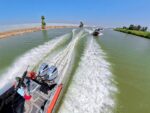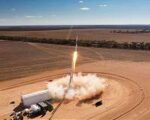Turkey’s next-generation unmanned combat aerial vehicle (UCAV), the Bayraktar Kızılelma, has achieved a significant milestone with the successful in-flight integration of ASELSAN’s MURAD active electronically scanned array (AESA) radar. This test marks a pivotal step toward enabling indigenous Turkish drones to conduct beyond-visual-range (BVR) air-to-air engagements and operate in contested environments with enhanced situational awareness.
Kızılelma Advances Toward Air Superiority Role
The Bayraktar Kızılelma is Turkey’s first stealthy jet-powered UCAV designed for high-end combat missions including suppression of enemy air defenses (SEAD), deep strike operations, and now increasingly—air-to-air combat. Developed by Baykar Technologies as part of Turkey’s growing domestic defense industry ecosystem, the platform represents a major leap from earlier tactical drones like the TB2 and Akıncı.
The recent flight test involving the integration of ASELSAN’s MURAD AESA radar was conducted at Akıncı Flight Training and Test Center. The radar was mounted on a prototype of the Kızılelma-B variant (also referred to as KIZILELMA-B or KE-B), which features an upgraded turbofan engine offering higher thrust compared to the initial KE-A configuration powered by Ukraine’s AI-25TLT engine.
MURAD AESA Radar: Capabilities and Strategic Impact
Developed by Turkish defense electronics giant ASELSAN under a contract awarded by Turkey’s Presidency of Defense Industries (SSB), the MURAD AESA radar is designed for multi-mode operation across air-to-air and air-to-ground domains. It supports key functions such as target detection and tracking at long ranges, synthetic aperture radar (SAR) imaging, ground moving target indication (GMTI), electronic beam steering, low probability of intercept (LPI), and electronic warfare resistance.
While ASELSAN has not disclosed full technical specifications publicly, open-source assessments suggest that MURAD offers detection ranges exceeding 100 km against fighter-sized targets with high-resolution tracking capability. The system is also being integrated into manned platforms such as the F-16 ÖZGÜR upgrade program and potentially Türkiye’s upcoming KAAN fifth-generation fighter jet.
For an unmanned platform like Kızılelma to carry such an advanced sensor suite signifies a doctrinal shift—enabling it not only to conduct ISR or strike missions but also to function as an autonomous or semi-autonomous interceptor in layered air defense architectures.
Flight Test Milestone Validates Integration Path
The flight test involved real-time operation of the MURAD radar onboard the UCAV during various maneuvers. According to official statements from Baykar and ASELSAN released in late October 2025 via social media channels and press briefings, all systems performed nominally. This suggests that power supply integration, thermal management systems for cooling the radar array, data processing pipelines onboard the drone’s mission computer suite—all functioned within design parameters.
This milestone follows earlier ground-based integration testing conducted throughout mid-2025. The airborne validation now opens pathways for further sensor fusion trials involving electro-optical/infrared payloads (EO/IR), electronic support measures (ESM), and potentially datalink-enabled cooperative engagement capabilities with other Turkish platforms like Akıncı or manned fighters via Link-16 or proprietary networks.
Implications for Turkish Airpower Doctrine
Kızılelma’s evolution into an air dominance-capable UCAV aligns with Turkey’s broader ambition to field a sovereign fifth-generation-like capability through unmanned means. The platform is designed with low observable features—internal weapons bays are planned in future variants—and can operate from short runways or even aircraft carriers like TCG Anadolu thanks to its STOL characteristics.
- Combat Radius: Estimated at over 800 km depending on payload configuration
- Payload Capacity: Up to ~1500 kg across internal/external stations
- Speed: Subsonic (~0.9 Mach) for KE-A; near-supersonic expected for KE-C variant under development
- Autonomy: AI-assisted mission planning; semi-autonomous BVR engagement roadmap underway
- Sensors: EO/IR turret; ESM suite; now integrated AESA radar
If successfully matured into serial production with full sensor fusion capabilities—including targeting pods and indigenous BVR missiles like GÖKTUĞ—the KIZILELMA could serve as both a loyal wingman-type adjunct or independent hunter-killer platform within Turkish airspace defense concepts.
AESA Integration Challenges and Next Steps
The inclusion of an AESA radar on an unmanned stealth platform presents several engineering challenges beyond simple hardware installation:
- Cooling requirements: High-power RF systems generate substantial heat; compact liquid cooling loops are required within tight fuselage constraints
- EMI shielding: Ensuring electromagnetic compatibility between mission avionics and high-frequency emitter arrays is critical
- Datalink bandwidth: Real-time transmission of high-resolution SAR imagery or BVR targeting data demands robust encrypted links—especially if operating beyond line-of-sight via SATCOM relays
The successful flight test suggests these hurdles are being addressed effectively within current prototypes. Future trials will likely involve live-fire tests using indigenous missiles such as Bozdoğan (WVR) or Gökdoğan (BVR)—both developed by TÜBİTAK SAGE—to validate end-to-end kill chain autonomy without human-in-the-loop intervention under certain rules-of-engagement scenarios.










